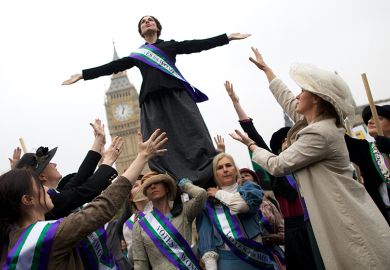The purpose of this book is to provide the reader with "brief discussions of some of the best books on over 500 topics and individuals in women's studies". In that purpose, the book certainly succeeds since its great bulk covers a wide range of material - not everyone would have thought of including the Bible and Buddhism as entries in an encyclopedia about women's studies.
The individual entries on the subjects covered here are written to a common pattern. There is a brief introduction to the person or topic, followed by a summary of those different accounts of the person/topic known to the writer of the particular entry. The information is generally helpful and accurate, but the critical literature cited is sometimes either incomplete or reads as if the author had just read the back cover or Internet summary of the book concerned. Thus the entry on Margaret Thatcher includes accounts of various biographies, but no mention of Thatcherism.
The mention of the Internet encourages (or discourages) me to think that this edition was written specifically for transmission on the World Wide Web. As far as I know, it may have been written on the web and then published in book form. The standardised format and the unhappy mix of apparent objectivity with outright subjectivity suggests that contributors and editor engaged in endless cut-and-paste work to make this collection. My picture of its composition is of an exercise in deleting all male individuals from standard works of reference and then writing the appropriate entries. Somehow or other Milton was left in, but of course Marx, Engels and socialism managed to get left out as separate entries.
Those omissions do suggest that a more accurate title for this work might be The North American Reader's Guide to Women's Studies. The guide does include, as its introductory note points out, material on other places, but even that note can annoy since one of the subjects claimed as being covered is the "American Industrial Revolution". In the same way, (all) Asian women get two and a half columns, which is only slightly more than the Women's Club Movement of the United States.
The considerable physical size of the collection does suggest that few general readers are expected to buy the book. Hopefully, they will turn to the excellent (and more portable) works of Terry Lovell, Maggie Humm, Diane Richardson et al for information about women's studies. What is disturbing about this work is the possibility both of its further dissemination through electronic transmission and the impact that the possibility of that transmission had on the form and content of the entries. It is not that the individual entries are specifically inaccurate, but rather that information is managed and packaged in a way that suggests more than the inevitable exclusions of all reference works: exclusion here is about a world literally, and metaphorically, outside the United States. When, for example, a reader comes across the entry on Women's Organisations and then finds that it is only about the United States there is a sense of irritation and unease. Did it not occur to anyone to add a qualifying statement about the location of these organisations? That it did not raises interesting questions, on which other pens have dwelt, about the relationship between particular kinds of feminism and cultural imperialism.
Mary Evans is professor of women's studies, University of Kent at Canterbury.
Reader's Guide to Women's Studies
Editor - Eleanor B. Amico
ISBN - 1 884964 77 X
Publisher - Fitzroy Dearborn
Price - £95.00
Pages - 732
Register to continue
Why register?
- Registration is free and only takes a moment
- Once registered, you can read 3 articles a month
- Sign up for our newsletter
Subscribe
Or subscribe for unlimited access to:
- Unlimited access to news, views, insights & reviews
- Digital editions
- Digital access to THE’s university and college rankings analysis
Already registered or a current subscriber?



